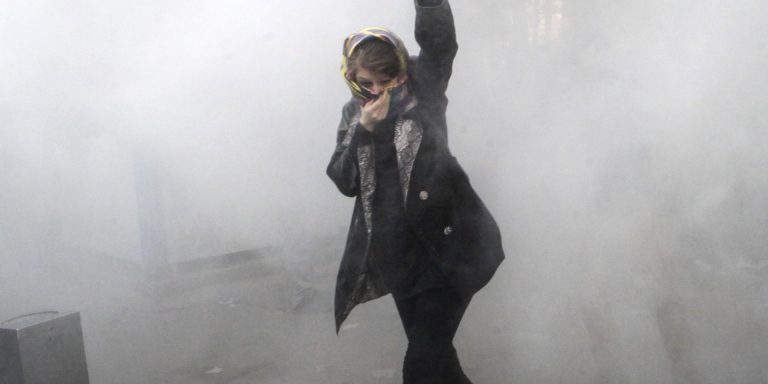INTELBRIEF
January 2, 2018
TSC IntelBrief: Unrest Erupts in Iran

• Protests in cities across Iran that began on December 28 remain leaderless and are unlikely to threaten the clerical regime’s grip on power.
• While at least 20 protestors have reportedly been killed, it seems likely that official acknowledgment of grievances, coupled with generally limited use of force, will gradually defuse the unrest.
• Unrest in Iran increases the stakes for the Trump Administration which faces a mid-January decision whether to remain in the 2015 multilateral nuclear agreement with Tehran.
• While the Trump Administration has offered the protestors rhetorical support, that can have only a marginal effect on the course of the protests.
On December 28, daily protests began breaking out in more than 30 Iranian cities, while remaining relatively limited in the capital, Tehran. The unrest was sparked by economic concerns among many poorer Iranians, including rising costs of key staple foods. The protests soon evolved into expressions of broader opposition to grievances including corruption, regime monopoly on political power, controls on freedom of expression—including conservative Islamic dress codes for women—and expensive interventions in the region’s many conflicts, particularly the Syrian civil war. While the protests have been mostly peaceful, some demonstrators have attacked local government offices and torn down pictures of the Supreme Leader, Grand Ayatollah Ali Khamenei.
The unrest would seem to contradict recent press reports that pressure on Iran by the U.S. and Saudi Arabia had increased public support for Tehran’s hardliners, and the regional interventions they sponsor. However, at this point the demonstrations do not appear to be of nearly the same size or scope as the mass unrest that gripped Iran in 2009, in the wake of perceived regime fraud in the re-election of hardline president Mahmoud Ahmadinejad. While some estimates claimed more than half a million people took part in those protests, they did not topple the regime, which suppressed demonstrators with significant use of force by the Iranian Revolutionary Guard Corps’ (IGRC) internal security forces, primarily the Basij loyalist militia. Meanwhile, the current protests are hampered by a lack of clear leadership and consensus over goals; particularly whether to seek broad regime changes or more limited political and economic reforms.
President Hassan Rouhani has staked his popularity on the economic benefits of the 2015 multilateral deal that curbed Iran’s nuclear program. He has sought to bring the unrest under control by acknowledging some grievances are legitimate, while warning of greater use of security forces against protestor violence. While the regime, for the most part, has allowed the protests to proceed, deadly force has been used in some localities, resulting in at least 20 protestor deaths to date. The government has also shut down several social media channels, including the Telegram instant messaging service protestors used to share information. The regime’s strategy appears to have prevented the unrest from escalating, although protests continue.
The one grievance the regime has not agreed to address is Iranian foreign policy: no Iranian leader has pledged to curtail Iran’s extensive and expensive support for Syrian President Bashar al-Assad, Lebanese Hizballah, Iraqi Shi’a militias, or the Zaidi Shi’a Houthi rebels in Yemen. Still, it is likely that the unrest will cause the regime to downplay its regional involvements, at least temporarily.
The sudden unrest has the Trump Administration confronting its policy choices towards Iran; a nation the Administration has made central to U.S. national security strategy. The demonstrations appear to support President Trump’s assertions that the Iranian regime is reviled by its population and a key threat in the Middle East. President Trump has further sought to contrast his reaction to the unrest to that of the Obama Administration to the wide-scale protests in 2009: issuing daily statements on his Twitter feed supporting the demonstrators and warning Tehran not to use force against them. However, U.S. officials have acknowledged there is little the United States can do to materially support the demonstrators. The Trump Administration appears to accept, as the Obama Administration did in turn, that any direct U.S. support could backfire by enabling the Iranian government to discredit the protestors as U.S. tools.
The timing of the unrest presents the White House with another dilemma, as it faces a major decision in mid-January 2018 on whether to continue to waive U.S. sanctions provisions under the 2015 multilateral nuclear deal. President Trump has consistently criticized the agreement, and threatened to withdraw from it last October, unless Congress and U.S. European allies can close loopholes regarding Tehran’s ballistic missile development and support for regional forces.
It is likely that some of President Trump’s advisers will argue in favor of renewing the waivers and keeping the U.S. in the accord, lest Washington’s withdrawal cause Iranians to rally around the regime. However, President Trump bucked those advisers last October, when he refused to certify that Iran was complying with its commitments. He may decide that withdrawing from the deal will further isolate the regime and boost the demonstrators—an outcome many Iran experts say is the opposite of what would likely happen. Whatever decision the White House makes will likely be marginal to the course of the unrest—unrest that is driven by factors internal to Iran itself.
For tailored research and analysis, please contact: info@thesoufancenter.org
.
.
[video width="1280" height="720" mp4="https://thesoufancenter.org/wp-content/uploads/2018/01/Final-Edit-1-99.mp4" poster="https://thesoufancenter.org/wp-content/uploads/2018/01/AP_18001419106826-copy-e1514914223769.jpg" autoplay="true"][/video]